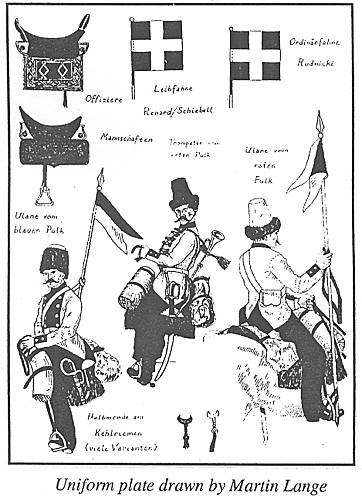 The Saxon army of the mid-eighteenth century was unique among its European contemporaries in its use of lance-armed light cavalry. The origin of the two Saxon lancer regiments, or Uhlanen pulks , probably comes from Poland, given that the Elector of Saxony also served as King of Poland during this period of time.
The Saxon army of the mid-eighteenth century was unique among its European contemporaries in its use of lance-armed light cavalry. The origin of the two Saxon lancer regiments, or Uhlanen pulks , probably comes from Poland, given that the Elector of Saxony also served as King of Poland during this period of time.
Uniform plate drawn by Martin Lange
There were two Saxon uhlan pulks, the Renard regiment or Red Pulk, and the Rudnicki regiment or Blue Pulk. Both units wore a black fur cap of medium height, and a long caftan- style overcoat of white cloth that had long sleeves, slashed to allow the arms to protrude through either the cuff or the sleeve. They wore long baggy trousers of red or blue and a long-sleeved waistcoat of the same color (hence the designation or red pulk and blue pulk). During the Seven Years War, the overcoat was embellished with a collar, cuffs, lapels and turnbacks in the facing colors.
Each pulk had an established strength of 600 men, divided into six to eight companies. During the 1740's, there were 75 men per company plus a kettledrummer and surgeon at the regimental level.
At the company level, we find 34 tovarczys, or noblemen, who were armed with lance, sword and pistols; 34 pocztavys , or commoners acting as servants to one of the afore-mentioned nobles,who were armed with carbine, pistols and sword, but no lance. The company also included one each of captain, lieutenant, and cornet, each of whom was attended by a pocztavy, plus one trumpeter. In battle, the tovarczys formed the front rank and were supported by the second rank of pocztavys. There does not appear to be anything approximating a squadron formation in the Saxon uhlan pulks.
It is thought that the trumpeters wore a uniform similar to that of the ranks, except for a conical hat in the pulk color, trimmed with black fur at the base. Their trumpets were made of brass and had crimson and white cords. There does not appear to be any special horse furniture for the trumpeters and kettledrummers, but undoubtedly both rode white horses in accordance with conventional standards of the time.
Lance pennants were split with a vee-shaped edge. The upper half was colored red or blue to conform with the regimental color, while the lower half of the pennant was white. Each pulk company carried a simple flag: background in the pulk color with a white cross, in a manner similar to French infantry standards. The flag staff was painted red and the company cornet carried the flag.
Most of this information comes from SYWA-member Martin Lange's fine article on Saxon Cavalry Organization that appeared in the August 1992 issue (#10) of the Seven Years War Study Group Bulletin. Martin's article also includes color uniform plates that he has drawn and these are particulary useful to anyone who wants to research and build a Saxon wargame army.
Back to Seven Years War Asso. Journal Vol. VII No. 1 Table of Contents
Back to Seven Years War Asso. Journal List of Issues
Back to Master Magazine List
© Copyright 1993 by James Mitchell
This article appears in MagWeb.com (Magazine Web) on the Internet World Wide Web.
Other articles from military history and related magazines are available at http://www.magweb.com